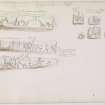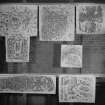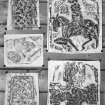Pricing Change
New pricing for orders of material from this site will come into place shortly. Charges for supply of digital images, digitisation on demand, prints and licensing will be altered.
Meigle
Cross Slab (Pictish), Pictish Symbol Stone (Pictish)
Site Name Meigle
Classification Cross Slab (Pictish), Pictish Symbol Stone (Pictish)
Alternative Name(s) Meigle Museum; Meigle Stones; Meigle No. 3
Canmore ID 30860
Site Number NO24SE 25.03
NGR NO 2872 4459
Datum OSGB36 - NGR
Permalink http://canmore.org.uk/site/30860
- Council Perth And Kinross
- Parish Meigle
- Former Region Tayside
- Former District Perth And Kinross
- Former County Perthshire
Meigle 3, Perthshire, Pictish cross-slab fragment
Measurements: H 0.41m, W 0.33m, D 0.07mm
Stone type: sandstone
Place of discovery: NO 2873 4460
Present location: Meigle Museum.
Evidence for discovery: when Skene sketched it in the early 1830s, it was built into the wall of the stable court at Kirkhill, with face C visible. Subsequently it was removed and the broken lower edge was cut back to form a tenon, as illustrated by Chalmers and Stuart in the mid nineteenth century. This tenon was later chiselled away for reuse as a building stone.
Present condition: only the top portion survives, on which some of the carving and the edges are damaged.
Description
This fragment belonged to a small grave-marker with a top shaped into a pediment. It is carved in relief on both broad faces, within a plain flat-band moulding. The width and height of face A are spanned by a cross with rectangular terminals and rounded armpits, the whole outlined by a roll moulding. A central roundel contains three spirals and the arms are filled with heavy diagonal key pattern. Below the left arm is part of a double-disc symbol, the surviving disc containing a spiral.
Face C is carved with a solitary warrior riding a horse cantering towards the left. The rider is bearded and has curly hair, and he is armed with a sword and spear. The sword scabbard has a D-shaped chap or protective terminal. He is sitting on a striped saddle-cloth which appears to show a slipper-stirrup in which his left foot is braced, but it may simply be a shoe.
Date: ninth century.
References: ECMS pt 3, 296-7; RCAHMS 1994, 98; Fraser 2008, no 189.2.
Desk-based information compiled by A Ritchie 2018
NO24SE 25.03 2872 4459.
The upper part of a gabled cross-slab was formerly built into the wall of the old parish church (NO24SE 33.00), and the lower part of the stone has been re-shaped on two occasions; the slab now measures 0.41m in height, 0.33m in width and 0.07m in thickness. The cross has rounded armpits and is decorated with key-pattern around a central triple spiral; to the left of the shaft there is a fragmentary double-disc symbol. On the back there is a bearded horseman with a spear, a sword in a scabbard with a chape, and a pointed shoe; his saddle-cloth bears
a striped pattern.
Chalmers, followed by Stuart, illustrated a tenon at the base of the fragment, as though the stone had been refashioned in antiquity in order to fit into a socketed recumbent slab, but the tenon no longer survives, and this feature is thus shown within dashed lines on the accompanying figure.
Information from RCAHMS (JNGR) 1990
P Chalmers 1848; J Stuart 1856.
Publication Account (1964)
No. 3 Upper part of upright cross-slab; decorated on the left of the shaft the top of the double-disc symbol: on the other side, a horseman wearing pointed shoes, armed with spear and sword. Note reins, bridle and saddle-cloth.
S Cruden 1964
















































